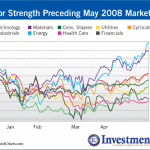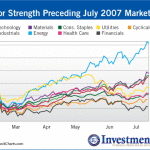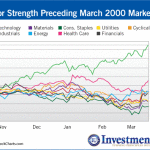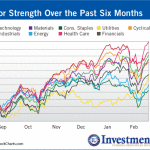Technical Tuesday: How to Detect Stock Market Tops – Investment U
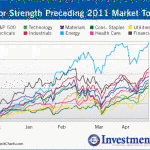
Technical Tuesday: How to Detect Stock Market Tops
by Chris Rowe, Director of Investor Education, The Oxford Club
Tuesday, February 18, 2014: Issue #2231
As I noted last week, bull market tops are often characterized by a breakdown of the sector that had led the market higher (like tech stocks in 2000 or financial stocks in 2007).
Another clue in our hunt for the top is the concentration of leadership to individual sectors. When we get near major (or even intermediate) bull market tops, we tend to see one sector (or sometimes two related sectors) breaking clearly away from the others.
Take 2011, for example, the year S&P 500 large caps dropped 19.4% and the Russell 2000 small caps tanked 29.6%.
Concentration of leadership in one sector was present in the six months prior to the market’s tumble.
The market topped on April 29, 2011. Below, you can see that in the six months preceding the fall, the energy sector broke away from the other sectors by more 10% on average.
We saw something similar in 2008, when the S&P 500 declined more than 40% from May 19 to October 27. Concentrated leadership also preceded that top.
Below, we see the leadership was concentrated in the energy and materials sectors – basically, commodities. These sectors were up nearly 18% and nearly 14%, respectively, over the six months prior to May 19, while most other sectors were down or up minimally.
Then there was the market top of July 2007. As we’d expect, we saw a particular sector – again, energy – generating most of the gains in the six months prior.
Because energy stocks had enjoyed a stellar performance from 2002 to 2007, one may think it impossible to use a concentrated-leadership analysis as a significant clue of a top.
Not the case.
Although the energy sector did outperform other sectors for much of the bull market, when I randomly studied multiple six-month time frames that ended with the general stock market charging higher – but not close to a top – the energy sector blended right in with the other sectors’ performance.
When it diverged far above the other sectors was when the market was nearing its top.
That’s what we saw leading up to the July 16, 2007, bull market top.
During the six months prior to that date, energy was up 26%, while none of the other major sectors were up more than 13%. Over the following month, the market shed 9.22%.
And finally, we all remember the tech sector going parabolic in 1999 while the other sectors were already trying to get their bear market going. The broader market topped in March 2000, losing nearly 47% over the next 2 1/2 years.
The tech sector was almost 55% higher in the six months prior to March 2000, while every other sector was roughly flat or down.
Now the good news: We are not seeing anything like this kind of concentrated strength in the sector that has led our current bull market, consumer discretionaries, or any major sector.
Think of the stock market in terms of separate time frames: short term (days to weeks), intermediate term (weeks to months), and long term (months to years).
We have certainly seen some market weakness in the intermediate term. But we must remain long-term bulls until we see much more evidence of a long-term top, such as significantly concentrated leadership.
Long-term tops take a long time to form so there will be plenty of time to adjust accordingly as they unfold. Over the last couple of months the market has only been punished like a misbehaving child.
In future articles I’ll update you when we see significant concentration of leadership into any single sector. For the intermediate term you’ll want to trade a bit more cautiously than in 2013.
Good investing,
Chris
VN:F [1.9.22_1171]
please wait…
Rating: 0.0/5 (0 votes cast)
Topics:Russell 2000
,
See original article:
Technical Tuesday: How to Detect Stock Market Tops – Investment U
See which stocks are being affected by Social Media


